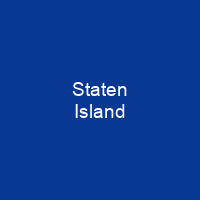Staten Island is a borough of New York City, coextensive with Richmond County. The borough is separated from New Jersey by the Arthur Kill and the Kill Van Kull. With an estimated population of 476,143 in 2019, Staten Island is the least-populated of the boroughs. The area was part of Lenape homeland known as Lenapehoking.
About Staten Island in brief

Shellfish was a staple of their diet, including the oyster abundant in the region. Evidence of the first permanent Native American settlements and agriculture are thought to date from about 5,000 years ago, although early archaic habitation evidence has been found in multiple locations on the island, including Burial Ridge, the largest pre-European burial ground in New York. In Lenape, one of the Algonquian languages,. Staten Island was called Aquehonga Manacknong, meaning \”as far as the place of the bad woods\”, or Eghquhous, meaning “the bad woods\”. The Lenaping were later called the “Delaware” by the English colonists because they inhabited both shores of what the English named the Delaware River. The island was laced with Native American foot trails,. one of which followed the south side of the ridge near the course of present-day Richmond Road and Amboy Road. It was consolidated with New. York City in 1898, and was the Borough of Richmond until 1975, when its name was changed to Borough of Staten Island. It has sometimes been called ‘the forgotten borough’ by inhabitants who feel neglected by the city government. The Staten Island subway system is the only borough that is not connected to the New York city Subway system. It runs from Brooklyn to Staten Island and from Staten Island to New York Bay.
You want to know more about Staten Island?
This page is based on the article Staten Island published in Wikipedia (as of Dec. 06, 2020) and was automatically summarized using artificial intelligence.







